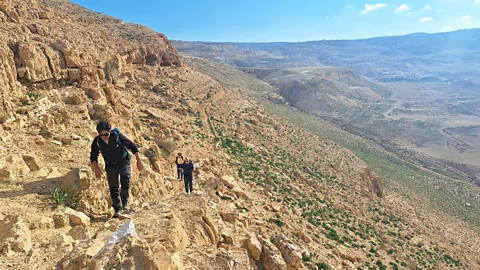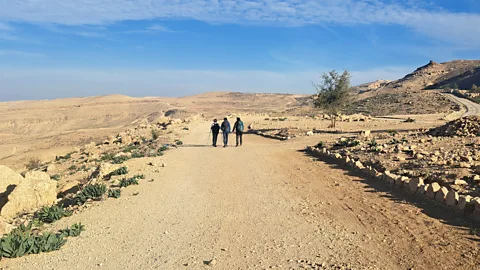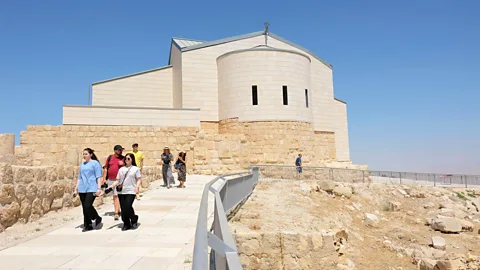The revival of Jordan's 1,600-year-old camino
 Silvano Mezzenzana
Silvano MezzenzanaIn Jordan, a 50km pilgrimage trail follows the path of a 4th-Century nun who journeyed through the Holy Land – centuries before Spain's famed Camino de Santiago.
The hike begins early in the morning at Mount Nebo, a sacred mountain 610m above sea level in Jordan. On a clear day, panoramic views of the Dead Sea, Bethlehem and Jerusalem stretch across the horizon. According to the Bible, it is the last place Moses gazed upon before his death. Today, it's the first sight walkers see as they set out on their journey along the Camino de Egeria, a pilgrim route first taken by a 4th-Century nun.
The view is "magical", says Silvano Mezzenzana, who recently undertook the three-day hike. He recalls standing atop that peak on the Moab plateau, a dry Sun fanning out over the ridges and farmland beneath, noting that it is fascinating both in the morning when the Sun lights up the Palestinian bank and the city of Jericho, and in the afternoon when the sunset draws the silhouettes of the hills of Judah up to Jerusalem. Up there, "you do not realise that you are on a mountain", he adds.
Beginning on the eastern edge of the Great Rift Valley, the 50km route winds through farmland and rugged hills – a voyage that is far greener than its European equivalent, the 800km Camino de Santiago pilgrim trail undertaken by around 500,000 people each year. Following the January announcement from Jordan and Spain of a merger twinning the Camino de Egeria with the Camino de Santiago to boost their respective cultural heritage, locals hope that the newly-renovated Middle Eastern trail can become a similar phenomenon. The goal is to highlight the significance of the eponymous Egeria, the Spanish nun believed to have travelled by donkey from Jordan through Palestine, Egypt, Syria, Mesopotamia and Asia Minor to visit the holy places recounted in the Bible. She is thought to be the first woman to make the journey, which pre-dates the famed Camino de Santiago by five centuries.
The hike is typically split up into three days (though can be done as quickly as in two, or a leisurely five). The terrain is not particularly challenging, but the distance – of around 17km per day – makes the hike unsuitable for total novices. Last year, wide paths were fixed between the rocky valleys and hills along much of the route, ushering in what the Ministry of Tourism hopes will mark a new era for international interest in the country.
 Silvano Mezzenzana
Silvano MezzenzanaThe effort is already seeing results. "Although I have lived in Jordan all my life, walking this trail has shown me parts of the country I've never experienced before," says Nadeen Dabbas. She recalls the flow of the water at the Moses Springs and the Jordan Valley, where she was surrounded by fields of bananas and corn, as moments that "made me feel alive".
The Best of 2025
Jordan was named one of BBC Travel's 25 best places to visit in 2025, a list highlighting destinations that are not only welcoming visitors, but using tourism as a force for good. See the full list here.
The first major landmark on day one features a small monastery built by Egyptian monks in Moses' memory, built in the latter half of the 4th Century, enlarged a century later and rebuilt in the 6th Century to a mosaic-filled basilica that still stands today. The trail then passes through the ancient city of Livias, before reaching its showpiece on day two: Al-Maghatas, or Bethany beyond the Jordan. A Unesco World Heritage site, this is believed to be the location where Jesus was baptised by John the Baptist. Pilgrims can explore Byzantine and Roman remains of chapels, churches and monasteries, along with the cave of John the Baptist, and even "spend the second night there in one of the pilgrim houses of Bethany, just next to the Jordan River", explains Oscar Koshebye, a guide who helped formalise the current tourist trail. The route finishes here, or at the King Hussein Bridge at the Jordan-Israel border.
While the hike offers striking natural beauty, the real draw may prove to be the woman who likely inspired it. "Egeria's account is significant because it is one of the oldest written accounts of pilgrimage to the Holy Land that has survived – and the first incontrovertibly penned by a woman," says Anne McGowan, associate professor of liturgy at the Catholic Theological Union and co-author of Pilgrimage of Egeria. Egeria's work was little-known until the 1880s, McGowan adds, originally written in the form of letters to her "sisters" (likely holy women similar to herself). An incomplete manuscript dating to the 11th Century is currently the oldest known record of her route.
 Silvano Mezzenzana
Silvano MezzenzanaEgeria travelled during the 4th Century, when many Christians took long-distance pilgrimages – something that fell out of favour from the 7th Century until around the mid-19th (aside from a "blip" in the wake of the Crusades, in the 12th-13th Centuries), McGowan explains. At that point, "travel to the Holy Land became easier once again. Going on pilgrimage aligned well with the Romantic Era's renewed enthusiasm for the personal and the subjective on the one hand and an idealised past on the other; and Protestants as a group became more intrigued by pilgrimage possibilities connected to places associated with the life and death of Jesus in a way they hadn't been previously."
But now, with religious appetite dwindling (a study published last year found that atheists now outnumber theists in the UK), Koshebye is hoping that a new generation can be drawn in. "We can consider it now, after centuries of abandonment, a route for tolerance between faiths, a way to improve intercultural exchange," he says.
Plan your trip
The Egeria Way branch office is at the Kawon bookshop in Madaba. From here, registered visitors will be taken to trail's start point, 15km away in Mount Nebo. Packages from different tour operators will soon be offered by the Egeria Way Association. Travel within Jordan is safe, though the UK Foreign Office advises against travel within 3km of the border with Syria.
The Spanish national and keen hiker began mulling a walking route to Jerusalem five years ago. Having already walked the Spanish Camino, he mentioned his plans to his father, who likened his son's idea to the devout Egeria – who he had never heard of. Koshebye began reading about the nun and scouring old maps in search of her original route. He later made a YouTube video about his plans, was contacted by the Jordanian tourist board, and then got in touch with the Spanish embassy in Jordan – a series of collaborative efforts that led to the merger being born.
More like this:
• The Wadi Rum Trail: Jordan's new long-distance hike
Koshebye hopes that the partnership leads to a surge of interest in this three-day version of the hike and wants it to be extended a further 30km to Jerusalem, another stop on Egeria's route. Plans for signage along the Jordanian route and more guesthouses where walkers can rest in between are already afoot.
 Alamy
AlamyWhile steeped in religious significance, ancient routes of this kind aren't just for those intent on retracing paths drawn by scripture, McGowan says. "Taking a very long walk still has the capacity to pull one into an inner journey. Younger people are still spiritual seekers, even if their search is typically less closely tied to traditional religious beliefs and practices," she believes. "Their pilgrimages might be more oriented toward the experience of journeying itself, as it seems Egeria's was as well; she does not so much set out on a round trip to visit one particular place, for example, as to experience as many places as possible."
With time – and a few more signposts – those involved in the project hope that Jordan's historic trail can achieve the same cultural significance as its Spanish counterpart. Mezzenzano, for one, has no doubt. "I would not only recommend" the trail, he enthuses, "but I plan to repeat it".
--
If you liked this story, sign up for The Essential List newsletter – a handpicked selection of features, videos and can't-miss news, delivered to your inbox twice a week.
